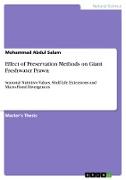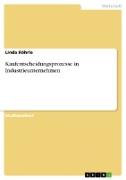- Start
- Effect of Preservation Methods on Giant Freshwater Prawn
Effect of Preservation Methods on Giant Freshwater Prawn
Angebote / Angebote:
Master's Thesis from the year 2004 in the subject Biology - Zoology, grade: M SC, Jahangirnagar University (Faculty of Biological Sciences), course: Fisheries (Zoology), language: English, abstract: To inquest a pertinent technology of preservation seasonal (summer, autumn, winter) nutritive values, effects of potassium sorbate, gamma radiation and their combinations preserved at low temperature on sensory, chemical and microbial properties of freshwater prawn (Macrobrachium rosenbergii, de Man-1879) as well as isolation and identification of associated micro-flora with their sensitivity to potassium sorbate and gamma radiation were investigated during February 2003 to April 2004. Nutritive analysis marked seasonal and body-part variations in moisture, protein, lipid, ash, calcium and phosphorus contents i.e., summer, autumn and winter as 80.07%, 80.37%, 76.99%, 19.20%, 18.03%, 21.30%, 1.23%, 1.07%, 2.99%, 1.48%, 2.00%, 1.21%, 0.19%, 0.21%, 0.14% and 0.10%, 0.08% & 0.10% in edible-part while 77.27%, 76.27%, 73.34%, 16.45%, 17.03%, 19.79%, 1.40%, 1.02%, 4.33%, 6.60%, 7.33%, 6.25%, 2.24%, 2.78%, 1.67% and 0.17%, 0.15% & 0.21% in head-on respectively.
Quality appraisal of treated (potassium sorbate-2%, gamma radiation-2kGy and their combination) and preserved (00C and 40C) samples were done by organoleptic, chemical and microbial evaluation at an interval of 7 days. The shelf life of freshwater prawn at 40C was 14-21 days which was extended to 21-28 days at 00C. Maximum shelf-life (28 days) was found in combined treated prawn that was stored at 00C.
Associated micro-flora were isolated and identified based on their cultural, microscopic, biochemical & physiological characteristics. Among 30 bacterial strains - thirteen (40.33%) were collected from control, nine (30%) from chemical treated, five (16.67%) from radiation treated and three (10%) from combined treated samples. Total 9 bacterial species were identified in which Staphylococcus aureus (23.33%), Bacillus subtilis (20.33%), Micrococcus varians (16.67%) and Escherichia coli (13.33%) were frequent species. Among 10 mould strains - seven (70.00%) were collected from control, three (30.00%) from radiation treated while no colonies were found from chemical and combined treated samples. Total 4 genus of moulds were identified in which Aspergillus (40.00%) was dominant. Potassium sorbate (0, 1, 2, 3, 4 & 5 %) and gamma radiation (0, 2, 4, 6, 8 & 10 kGy) were applied for the sensitivity on identified bacterial species. Staphylococcus aureus, Bacillus subtilis, Micrococcus varians & Escherichia coli were completely eliminated at 4, 5, 3 & 4 % potassium sorbate and 6, 8, 4 & 6 kG gamma radiation doses.
Folgt in ca. 10 Arbeitstagen

